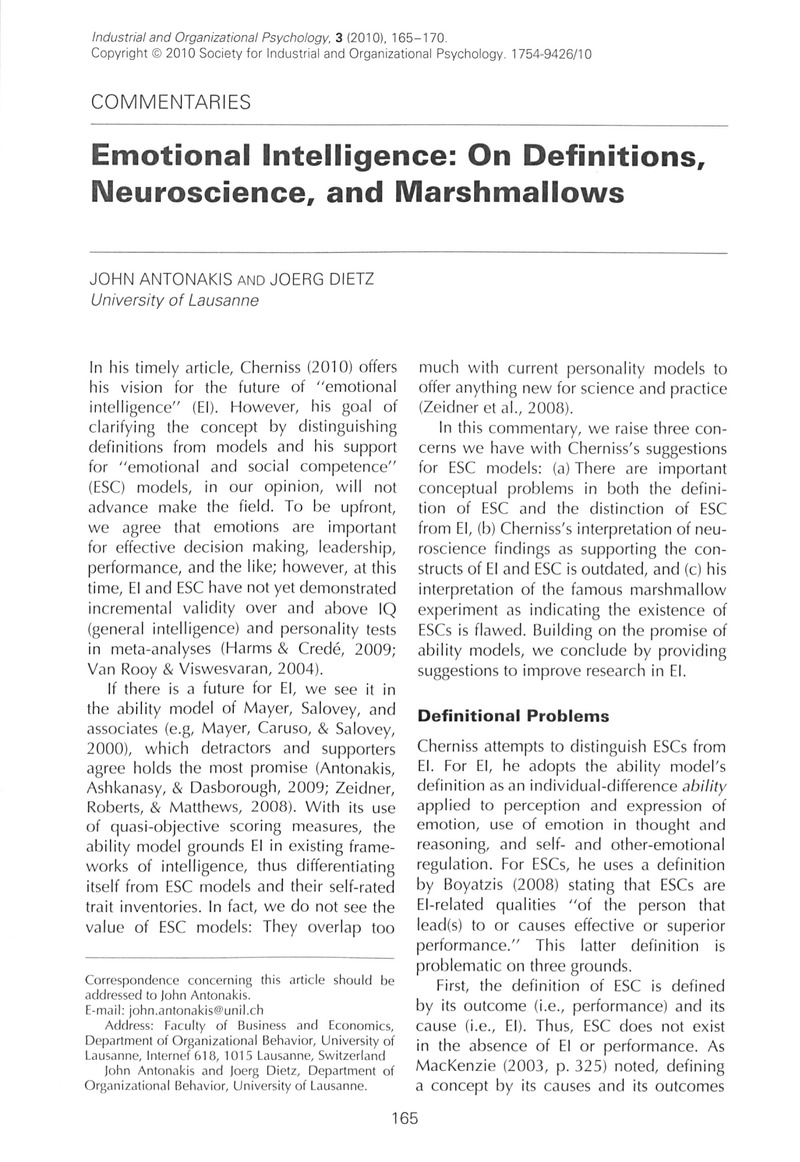Crossref Citations
This article has been cited by the following publications. This list is generated based on data provided by Crossref.
Cherniss, Cary
2010.
Emotional Intelligence: New Insights and Further Clarifications.
Industrial and Organizational Psychology,
Vol. 3,
Issue. 2,
p.
183.
Antonakis, John
Bendahan, Samuel
Jacquart, Philippe
and
Lalive, Rafael
2010.
On making causal claims: A review and recommendations.
The Leadership Quarterly,
Vol. 21,
Issue. 6,
p.
1086.
Antonakis, John
and
Dietz, Joerg
2011.
More on testing for validity instead of looking for it.
Personality and Individual Differences,
Vol. 50,
Issue. 3,
p.
418.
Antonakis, John
and
Dietz, Joerg
2011.
Looking for validity or testing it? The perils of stepwise regression, extreme-scores analysis, heteroscedasticity, and measurement error.
Personality and Individual Differences,
Vol. 50,
Issue. 3,
p.
409.
McCleskey, Jim
2014.
Emotional intelligence and leadership.
International Journal of Organizational Analysis,
Vol. 22,
Issue. 1,
p.
76.
Giorgi, Gabriele
Mancuso, Serena
and
Fiz Perez, Francisco Javier
2014.
Organizational Emotional Intelligence and Top Selling.
Europe’s Journal of Psychology,
Vol. 10,
Issue. 4,
p.
712.
Grunes, Paul
Gudmundsson, Amanda
and
Irmer, Bernd
2014.
To what extent is the Mayer and Salovey (1997) model of emotional intelligence a useful predictor of leadership style and perceived leadership outcomes in Australian educational institutions?.
Educational Management Administration & Leadership,
Vol. 42,
Issue. 1,
p.
112.
Fiori, Marina
Antonietti, Jean-Philippe
Mikolajczak, Moira
Luminet, Olivier
Hansenne, Michel
Rossier, Jérôme
and
Brucki, Sonia
2014.
What Is the Ability Emotional Intelligence Test (MSCEIT) Good for? An Evaluation Using Item Response Theory.
PLoS ONE,
Vol. 9,
Issue. 6,
p.
e98827.
Michelangelo, Lori
2015.
The overall impact of emotional intelligence on nursing students and nursing.
Asia-Pacific Journal of Oncology Nursing,
Vol. 2,
Issue. 2,
p.
118.
Keefer, Kateryna V.
Parker, James D. A.
and
Saklofske, Donald H.
2018.
Emotional Intelligence in Education.
p.
1.
2018.
The Emerald Review of Industrial and Organizational Psychology.
p.
767.
Waldman, David A.
Wang, Danni
and
Fenters, Virgil
2019.
The Added Value of Neuroscience Methods in Organizational Research.
Organizational Research Methods,
Vol. 22,
Issue. 1,
p.
223.
Cristofaro, Matteo
Giardino, Pier Luigi
Malizia, Andrea P.
and
Mastrogiorgio, Antonio
2022.
Affect and Cognition in Managerial Decision Making: A Systematic Literature Review of Neuroscience Evidence.
Frontiers in Psychology,
Vol. 13,
Issue. ,
Bodrogi, Barbara
Bereczkei, Tamas
and
Deak, Anita
2022.
Be aware, make it clear, and take the Lead: emotion regulation difficulties and emotional intelligence as moderators of cognitive reappraisal.
Current Psychology,
Vol. 41,
Issue. 10,
p.
6795.
Maddocks, Jo
2023.
Introducing an attitude-based approach to emotional intelligence.
Frontiers in Psychology,
Vol. 13,
Issue. ,





